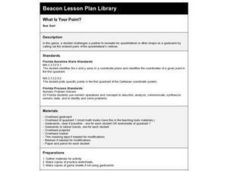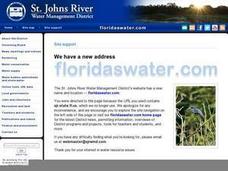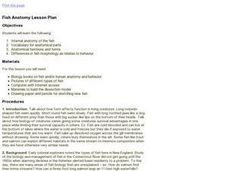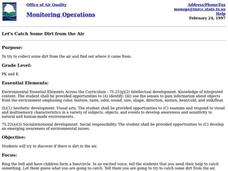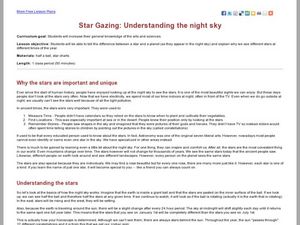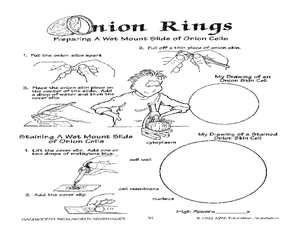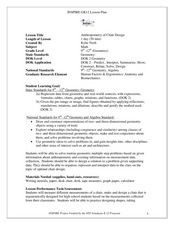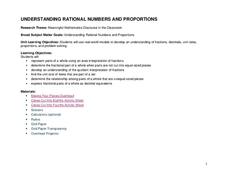Curated OER
What Is Your Point?
Sixth graders identify the x and y axes in a coordinate plane and identifies the coordinates of a given point in the first quadrant. They plot specific points in the first quadrant of the Cartesian coordinate system.
Curated OER
Gingerbread Baby v. Gingerbread Boy #7
Students compare and contrast the gingerbread baby in their story to the original gingerbread boy. They use a Venn diagram to easily see the similarities and differences.
Curated OER
Gingerbread Baby Language Arts/Grammer #6
Students are read the story "Gingerbread Baby". They draw and cut out the characters from the story and create a mobile to hang from their classroom ceiling. They write a sentence using a verb on the back.
Curated OER
Gingerbread Baby Board Game #10
Learners are read the book "Gingerbread Baby". They examine the journey the baby traveled in the story and in turn create a game board. They draw pictures along the board to show different parts of the story.
Curated OER
Choosing the Lincoln Statue
Fourth graders research photographs or artwork depicting Abraham Lincoln during the time when he was traveling the 8th Judicial Circuit and practicing law in Champaign County. They develop a Powerpoint presentation of the results of the...
Curated OER
Lesson 7 - Our Rivers and Streams
Learners examine the major rivers in Northeast Florida and how they are useful. They study the St. John's River, its tributaries, and unique characteristics.
Michigan Sea Grant
Exploring Watersheds
Collaboratively, students partake in a hands-on activity in which they build models of a watershed. Each group member draws an elevation map—a bird's eye view—of their model and predicts how water will flow from the high to low points....
Curated OER
Totem Poles -- Storytellers of Long Ago
Third graders discover the main purpose for totem poles was to communicate with others. In groups, they compare and contrast the four types of totem poles and the various symbols used. They write their own stories based off of pictures...
Curated OER
Glaciers of Canada
Students examine photos, a poster, maps and an article series by National Geographic to determine characteristics of glaciers and the process of glaciation. They both answer guided questions and develop their own questions about the...
Curated OER
Perplexing Perimeters
In the process of constructing their own "rulers" Students develop a sense of the size of a centimeter and meter. Students select the appropriate "ruler" for the tasks. Finally, 3rd graders calculate the perimeter of objects using...
Curated OER
Social Studies: Presidential Mock Interviews
Students, working in pairs, conduct mock interviews of American presidents, highlighting personal and political details. They research their chosen president on the Internet prior to their role-playing presentation. Students publish...
Curated OER
Facts, Fictions and Perceptions of Regions
Students examine the different characteristics of the regions of the United States. They discuss places they have visited in the U.S., and in small groups conduct research on a selected region of the U.S. Each group labels a map of...
Curated OER
Paper Bag Puppets
Students create "paper bag puppets" using basic art supplies, construction paper, and their imagination in this awesome early-elementary Art activity. The lesson includes a resource link and suggests teaching a short history of puppetry...
Curated OER
Fish Anatomy
Students identify and interpret the internal anatomy of the fish. They also identify and define vocabulary for anatomical parts and anatomical functions and forms. Finally, students identify and interpret the differences in fish...
Curated OER
Geology- Gemstones, Fossils and Rocks Quiz
In this earth science quiz worksheet, students answer 10 fill-in-the-blank questions about gemstones, fossils, and rocks. They see pictures of rocks, minerals, and a dinosaur fossil on the page. They check their answers with the word...
Curated OER
Let's Catch Some Dirt From the Air
Learners investigate the dirt in the air. In this air quality lesson, students use aluminum foil and petroleum jelly to discover if there is dirt in the air. Learners discuss results.
Curated OER
US Government: Foreign Policy
Students explore the basic precepts of American foreign policy. In this diplomacy lesson, students read textbook chapters regarding American foreign policy practices before and after World War II. Students also watch a...
Curated OER
Acting Out Verbs
Learners act out verbs. In this verbs lesson, students identify and highlight the action words in a poem. As a class, the learners act out the verbs, reinforcing the idea that verbs are action words.
Curated OER
Star Gazing: Understanding the night sky
Students observe star charts to understand the difference between a star and a planet. In this star lesson plan, students also explain why we see different stars at different times of the year.
Curated OER
Home Design
Young scholars investigate house structures by examining photographs. In this architecture lesson, students read the book Houses and Homes, analyzing the different structures and materials. Young scholars utilize mud to...
Curated OER
Onion Cells
Students observe the cells of an onion by wet mounting it and viewing it in a microscope. In this hands on instructional activity students make their own wet mount slide of an onion and are able to identify the cells in it such as,...
Curated OER
Data Representation
Students solve real life scenarios using math. For this geometry lesson, students collect, predict and interpret data. They measure a chair using different measurements and choose what would make the chair the best design.
Curated OER
The Search for Pythagoras' Treasure
Students identify and define properties of triangles. In this geometry lesson plan, students identify the missing sides and angles of right triangles. They use the rules of the Pythagorean Theorem to solve their problems.
Curated OER
Understanding Rational Numbers and Proportions
Students explore parts of a whole. In this fraction lesson, students determine what makes a fair share. Working with manipulatives, students solve mathematical problems containing fractions.
